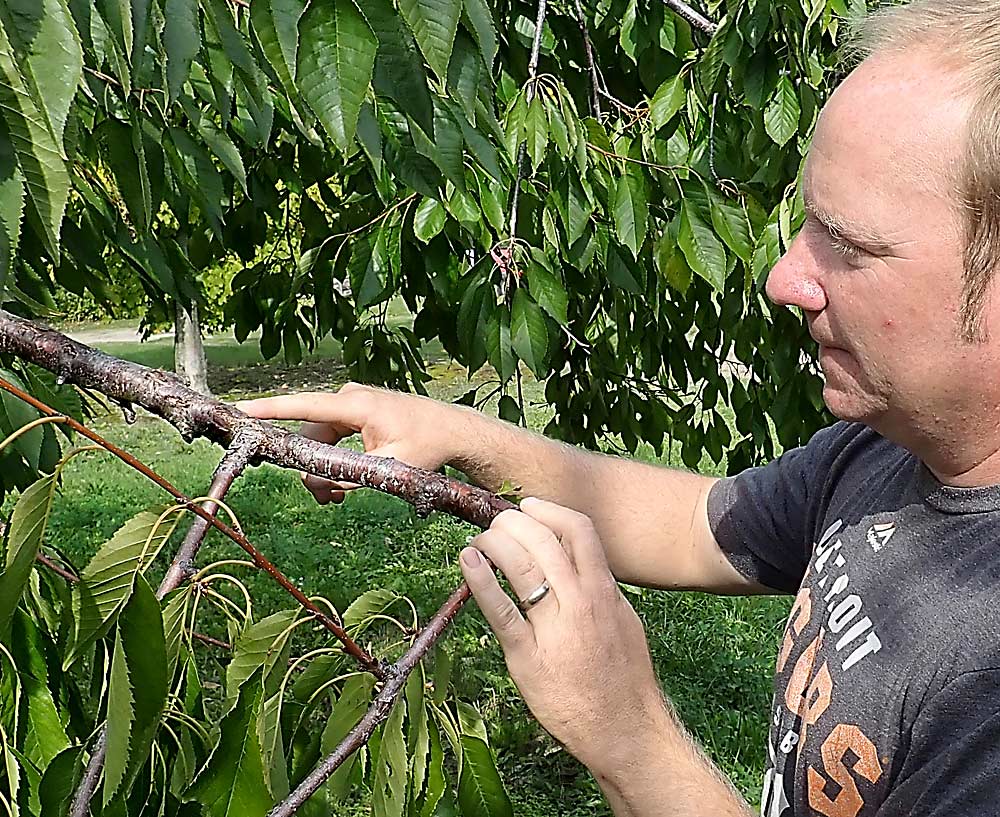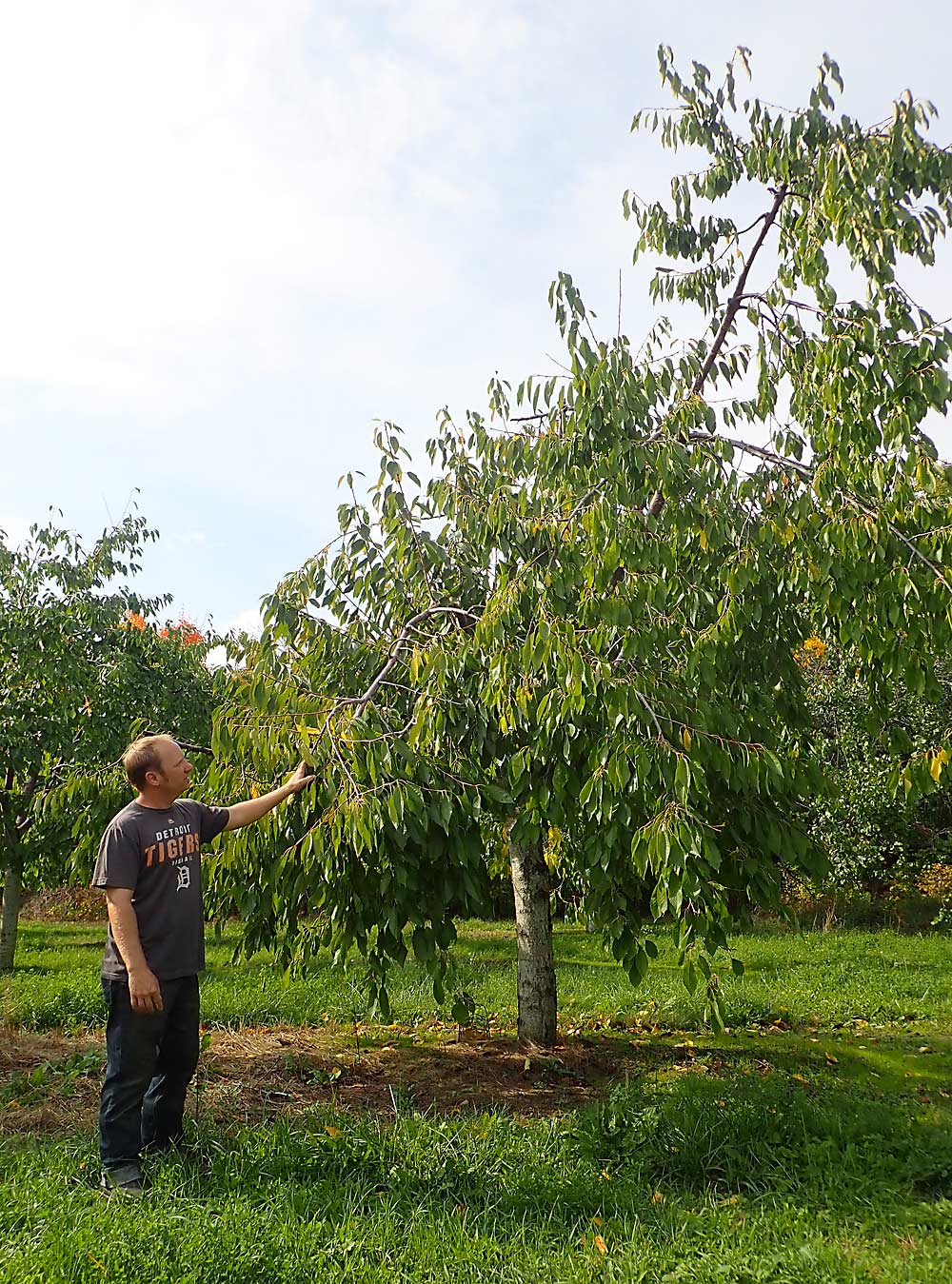
Jon Richter, owner of the 200-acre Richter Farm in Leelanau County, Michigan, examines a branch of a sweet cherry tree while looking for San Jose scale, which took a heavy toll on his trees in 2017. He says he lost 10 to 15 percent of the bearing surface in the trees. Those hit hardest were light sweet cherries, especially Gold, but some dark red varieties were also affected. (Leslie Mertz/for Good Fruit Grower)
San Jose scale has long been known as a pest on apples, leaving small, red marks on the surface of the fruit.
Last summer, Michigan State University Extension specialist Nikki Rothwell showed a group of regional fruit experts something many had never seen before: an infestation in sweet cherry trees. At one orchard in the northwestern Lower Peninsula, one-third of the trees were dead.

An example of San Jose scale (Diaspidiotus perniciosus). (Courtesy USDA Agricultural Research Service)
“The scale was killing the trees,” she said. “These guys were just stunned.”
Rothwell, who is coordinator of the Northwest Michigan Horticulture Research Center in Traverse City, first identified the scale insects in sweet cherries on Michigan’s Old Mission Peninsula in 2007.
It has since spread into sweets in nearby Leelanau and Antrim counties, and, in 2017, it came on with a vengeance, leaving many cherry orchards with severe die-off in the treetops.
One of those hit hard by scale in 2017 was Jon Richter, owner of the 200-acre Richter Farm in Leelanau County.
He first noticed scale in the orchard back in 2010 and had been managing it with spot treatments of oil, mainly to his Gold variety, which was the most vulnerable to the insects. However, the scale population escalated in 2017 and the insects moved beyond Golds to do considerable damage to Emperor Francis, Napoleon and Summit.
“We lost 10 to 15 percent of our bearing surface in the trees,” in 2017, he said. His other two varieties — Ulster and Sam — had little to no scale-related injury.
The scale outbreak was higher in apples that year, too. Leelanau grower and retired MSU extension agent Jim Nugent isn’t sure what’s behind the uptick. “We tend to be getting warmer, so that may be playing some role, but we don’t know if it’s a real correlation or not,” he said.
Another culprit might be changes in spray programs, especially the increased use of pyrethroids against spotted wing drosophila (SWD). “We had San Jose scale before we had SWD, but as we’ve shifted strategies to take down SWD, it could be that we’re accentuating the problem in scale,” he said.
Richter agreed. “We apply so many pyrethroids throughout the year that I think we’re killing many of the beneficial insects that might have previously been keeping the population of San Jose scale so low that we never really noticed them,” he said.
Scouting for scale
The best way to check for San Jose scale is to get up close to the upper branches; in the fall or early winter before snow are the best times to examine the tops of the trees, where an infestation usually starts.
“The limbs will be covered with these little white bumps, and if it’s really infested, the white can encase the limbs,” Richter said.
The insects are also visible in the spring, but only for a short time, he added. “The scale go behind the bark, and then the trees leaf out, and they’re just difficult to see.”
Once San Jose scale has been identified in sweet cherries, growers should take a few actions, Rothwell said. One is to prune out the dead wood and examine it for the insects.
Because the scale insects can look almost like bits of the peeling bark characteristic of cherry trees, MSU extension offices also invite growers to bring in a branch or send in a closeup photo of a branch, so extension experts can help with identification.
Once the dead wood is pruned, she urges growers to burn it to make sure the scale insects are dead.
Rothwell also recommends growers apply oil early in the spring to suffocate adult scale insects, and follow up by spraying for the immature scale insects, or crawlers, that hatch out a bit later. Unlike the adults that are shielded from insecticides by their waxy caps (called “scales”), crawlers have no such protection and can be killed with the sprays.
Unfortunately, the crawler stage only lasts a couple of weeks and no good method is yet available to tell exactly when that stage occurs, she said.
“We have a growing-degree-day model that we use for spraying crawlers in apples, but it is not a direct correlation to cherries,” she said. “I know it’s frustrating to growers, but we’re working on it.”
Growers should also reduce tree heights to get good spray coverage. “That’s a general recommendation that we’re always making, but if you’re having a problem with scale, it’s important to try to get the height down,” she said.
More research is necessary before she can provide additional suggestions to growers. “None of our research stations have had scale infestations on sweet cherries, so we haven’t been able to test new products or things that aren’t labeled, ” Rothwell said. “So at this point, we just don’t have good answers.”
After the rough year in 2017, Richter has become more aggressive against San Jose scale. Besides continuing his practice of pruning dead wood using a tower, he switched from doing only a spot application of oil to treating everything with oil combined with Lorsban, and he adds a pyrethroid spray to try to catch the crawler stage.
“I felt like we had to up our game, and we had pretty good results this past year. The trees look a lot better, and while things aren’t perfect, a lot of them have given us 2 to 3 feet of new growth, which makes me optimistic,” he said. “At least we are bringing the trees back.”

Richter is pleased with the tree recovery so far. This tree is typical of the response with 2 to 3 feet of new growth in 2018. (Leslie Mertz/for Good Fruit Grower)
What’s next
Now that San Jose scale has a toehold in sweet cherries in three Michigan counties, Rothwell thinks it will probably continue spreading.
“I do expect it to move out farther,” she said. “The growers who don’t have it can’t really wrap their heads around it until it shows up on their orchards. Then, it seems to hit pretty bad, and they see a lot of dieback and branches and sometimes trees quickly decline.”
Richter offers this advice to other sweet cherry growers: Be vigilant.
“If a bad infestation goes untreated, I think it could pretty much decimate an orchard or kill it off completely,” he said. “I think we’re going to have to consider it a pest here now, and I don’t think we’re ever going to get rid of it. But I do think we can keep it controlled to the point where we don’t have a problem with it.” •
—by Leslie Mertz






Leave A Comment